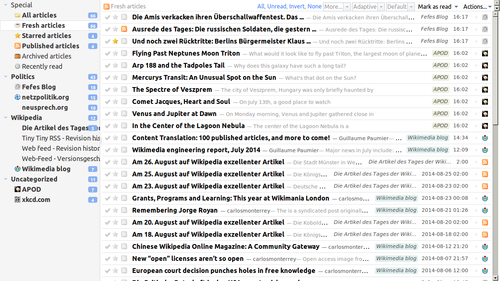| Atom | |
|---|---|
 | |
| Filename extension | .atom, .xml |
| Internet media type | application/atom+xml |
| Developed by | Internet Engineering Task Force |
| Initial release | RFC 4287 December 2005 |
| Type of format | Web syndication |
| Container for | Updates of a website and its related metadata (Web feed) |
| Extended from | XML |
| Open format? | Yes |
| Website | www |

The name Atom applies to a pair of related Web standards. The Atom Syndication Format is an XML language used for web feeds, while the Atom Publishing Protocol (AtomPub or APP) is a simple HTTP-based protocol for creating and updating web resources. [1]
Contents
- Usage
- Atom compared to RSS 2.0
- Date formats
- Internationalization
- Modularity
- Barriers to adoption
- Development history
- Background
- Initial work
- Atom 0.3 and adoption by Google
- Atom 1.0 and IETF standardization
- Example of an Atom 1.0 feed
- Including in HTML
- See also
- References
- External links
Web feeds allow software programs to check for updates published on a website. To provide a web feed, the site owner may use specialized software (such as a content management system) that publishes a list (or "feed") of recent articles or content in a standardized, machine-readable format. The feed can then be downloaded by programs that use it, like websites that syndicate content from the feed, or by feed reader programs that allow internet users to subscribe to feeds and view their content.
A feed contains entries, which may be headlines, full-text articles, excerpts, summaries or links to content on a website along with various metadata.
The Atom format was developed as an alternative to RSS. Ben Trott, an advocate of the new format that became Atom, believed that RSS had limitations and flaws—such as lack of on-going innovation and its necessity to remain backward compatible—and that there were advantages to a fresh design. [1]
Proponents of the new format formed the IETF Atom Publishing Format and Protocol Workgroup. The Atom Syndication Format was published as an IETF proposed standard in RFC 4287 (December 2005), and the Atom Publishing Protocol was published as RFC 5023 (October 2007).